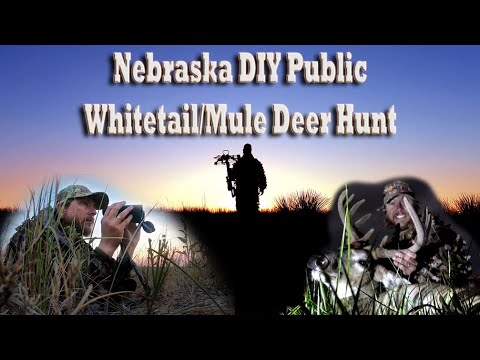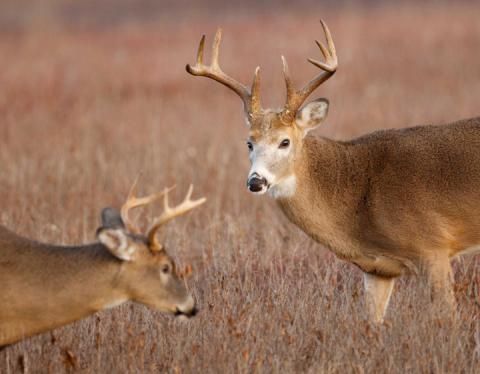
Can You Really Stalk Within Bow Range of a Mature Whitetail Buck?
Hunting whitetails in the West is different than in the Midwest or East. We have vast land here, which makes it difficult to pattern deer if you are a newbie. I’ve had success finding whitetails by glassing and then making a stalk.
If you’re used to hunting from a stand or blind, this may seem foreign. But my method for killing mature western bucks is to spot them and then make my move. If you’re headed out West to hunt whitetails this year, here’s how to get within bow range.
Hang a Deer Stand to Glass
The West is vast. Aside from a few river bottom areas, you won’t find massive hardwood tracts like in the Midwest and East. Western whitetails inhabit open landscapes and sparsely-timbered creeks, plains, and canyons. They move great distances during the rut, and a mobile approach is often the right choice.
Use a digital mapping app like HuntStand or onX to locate trees for your stand. Pay attention to deer sign when walking to and from. This isn’t a kill stand. It’s for observation. Don’t get bummed if the area isn’t littered with tracks. You’re using this stand to pinpoint bucks.
Glass From the Truck
When driving to your stand sites, stop often to glass. A huge part of hunting western whitetails is by glassing with your vehicle. Buy the best binoculars you can afford, as well as a quality spotting scope with a window mount. When I arrive at any western whitetail destination, the first thing I do is log miles in the truck. This is easy to do when driving between stand locales and looking for other prospective observation trees.
When sitting in the truck or an observation stand, pay close attention to how deer use the landscape. Typically, I spend an entire day taking note of how deer move. It won’t take long to identify a popular sage flat that ties into an old dry creek bed that leads to a willow-rich bedding area. A little pinch between cedar-dotted hills that sprawls out into a giant cactus or sage flat is also a great area to find bucks going to bed or pushing a ready-to-breed doe.
Make a Move

Once you locate a buck, take note of landmarks before your stalk. Few things trump the excitement of stalking a whitetail, and for some, this tactic sounds impossible. Stalking a mature whitetail is possible if you stay patient and do it right.
If you spot a bedded buck or watch a buck bed down, don’t spring into action. Make sure the wind is right. Then, mark your location and the location of the bedded buck. This will give you a visual reference during the stalk. Photograph distinguishable landmarks between you and the target animal. The more visual references you have, the better your chances of getting close.
When on your stalk, trust your pre-scouting work and stay hidden. I’m also a big believer in shadows. If you run out of stalking real estate for a moment or need to make a risky move, shadows help a lot. If there are scattered clouds, wait for one to cover the sun.
Lastly, when you get in position, you have two options. First, grunt or snort-wheeze to get the buck to stand. Second, wait for the buck to stand on his own. When stalking, I prefer the second option. Yes, it may be a long wait, but what does that matter? You’ve done everything right. Don’t rush it.
Use a Bow-Mounted Decoy
My favorite western whitetail tactic is to use a bow-mounted decoy. Place a quality 3-D buck decoy in an open area. Attach either a Stalker Doe from Ultimate Predator Gear or a Whitetail Doe Decoy from Heads Up to your bow. Get on the downwind side of your buck imposter and find cover—sage or cedars will work.
This situation simulates a buck tending a doe, and most bucks can’t resist coming in. It’s the norm for a mature buck to approach the 3-D buck aggressively and without caution, giving you plenty of time to draw your bow and capitalize. Don’t be afraid to move a little. Remember, you are part of the decoy scheme. If a buck hangs up, reach up and flick the ear of your bow-mounted decoy or move your riser side-to-side.
On those occasions where you watch a buck take a doe to tend her, slap a pair of antlers on your bow-mounted decoy, and use the terrain to close the distance. Bucks don’t take kindly to other bucks wandering into their rut party. If you can get close, you have a great chance of killing the buck.
I like to get within 50 or 60 yards of the bedded pair and then grunt loudly. Usually, a single grunt is enough to get the buck to stand and see the bow-mounted decoy. Stay patient. I’ve had bucks react instantly, while others will paw the earth, or hook vegetation with their horns and toss it into the air. If a buck does this but refuses to budge, grunt again and this time, add a snort-wheeze.

A skilled hunter, dedicated conservationist, and advocate for ethical practices. Respected in the hunting community, he balances human activity with environmental preservation.
